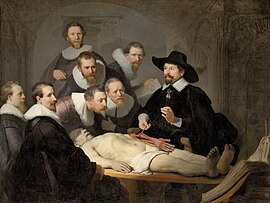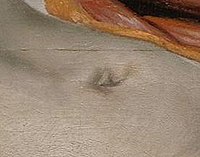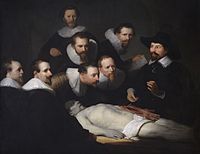The Anatomy Lesson of Dr. Nicolaes Tulp
| The Anatomy Lesson of Dr. Nicolaes Tulp | |
|---|---|
 | |
| Artist | Rembrandt |
| Year | 1632 |
| Medium | Oil on canvas |
| Movement | Baroque painting,Dutch Golden Age painting |
| Dimensions | 216.5 cm × 169.5 cm (85.2 in × 66.7 in) |
| Location | Mauritshuis,The Hague |
The Anatomy Lesson of Dr. Nicolaes Tulpis a 1632oil paintingoncanvasbyRembrandthoused in theMauritshuismuseum inThe Hague,theNetherlands.It was originally created to be displayed by the Surgeons Guild in their meeting room.[1]The painting is regarded as one of Rembrandt's early masterpieces.
In the work,Nicolaes Tulpis pictured explaining themusculatureof thearmto a group ofdoctors.Some of the spectators are various doctors who paidcommissionsto be included in the painting. The painting is signed in the top-left hand cornerRembrandt. f[ecit] 1632.This may be the first instance of Rembrandt signing a painting with his forename (in its original form) as opposed to the monogramRHL(Rembrandt Harmenszoon ofLeiden), and is thus a sign of his growing artistic confidence.
Background[edit]
The event can be dated to 31 January 1632: theAmsterdamGuild ofSurgeons,of which Tulp was official City Anatomist, permitted only one publicdissectiona year, and the body would have to be that of an executed criminal.[2]
Anatomylessons were a social event in the 17th century, taking place in lecture rooms that were actualtheatres,with students, colleagues and the general public being permitted to attend on payment of an entrance fee. The spectators are appropriately dressed for this social occasion. It is thought that the uppermost (not holding the paper) and farthest left figures were added to the picture later.[3]
Every five to ten years, the Surgeon's Guild would commission a portrait by a leading portraitist of the period; Rembrandt was commissioned for this task when he was 25 years old, and newly arrived in Amsterdam. It was his first major commission in Amsterdam. Each of the men included in the portrait would have paid a certain amount of money to be included in the work, and the more central figures (in this case, Tulp) probably paid more, even twice as much. Rembrandt's anatomical portrait radically altered the conventions of the genre, by including a full-length corpse in the center of the image (using Christ-like iconography) and creating not just a portrait but a dramaticmise-en-scène.Rembrandt's image is a fiction; in a typical anatomy lesson, the surgeon would begin by opening the chest cavity and thorax because the internal organs there decay most rapidly.
One person is missing: the Preparator, whose task was to prepare the body for the lesson. In the 17th century an importantscientistsuch as Tulp would not be involved in menial and bloody work likedissection,and such tasks would be left to others. It is for this reason that the picture shows no cutting instruments. Instead we see in the lower right corner an enormous opentextbookon anatomy, possibly the 1543De humani corporis fabrica(Fabric of the Human Body) byAndreas Vesalius.
The corpse[edit]
The corpse is that of the criminal Aris Kindt (alias of Adriaan Adriaanszoon), who was convicted for armed robbery and sentenced todeathbyhanging.He was executed earlier on the same day of the scene.[4]The face of the corpse is partially shaded,[2]a suggestion ofumbra mortis(shadow of death), a technique that Rembrandt was to use frequently.

The French art historian Jean-Marie Clarke suggests that the navel of the corpse has the shape of a capital R and connects this observation to the fact that Rembrandt worked intensively on his signatures in 1632, using three types consecutively before settling on the final, first name form in 1633.[5][6]
Kindt was discussed in the 1999 novelThe Rings of SaturnbyW. G. Sebald,and plays a significant role inLaird Hunt's 2006 novelThe Exquisite.In her 2014 historical fiction novelThe Anatomy Lesson,author and journalist Nina Siegal tells the life story of Aris Kindt, based on documents about his criminal history that she discovered in the Amsterdam city archives.
Medical specialists have commented on the accuracy ofmusclesandtendonspainted by the 26-year-old Rembrandt. It is not known where he obtained such knowledge; it is possible that he copied the details from an anatomical textbook. However, in 2006 Dutch researchers recreated the scene with a male cadaver, revealing several discrepancies of the exposed left forearm compared to that of a real corpse.[7][8]
In a 2007 study, the American artist and anatomist David J. Jackowe and his colleagues demonstrated that the mysterious white cord that courses along the ulnar aspect of the cadaver's carpus and little finger, long thought to be either an ulnar nerve variant or artistic error, is most likely the tendon of a variant forearm muscle, the accessoryabductor digiti minimi.[9]
Related works[edit]

The Anatomy Lesson of Dr. Deijman,painted by Rembrandt in 1656, was intended to be displayed in the Anatomical Hall in Amsterdam alongsideThe anatomy lesson of Tulp.[10] Deijman was Tulp's immediate successor in the post ofpraelector chirugic et anatomie.The painting was damaged by fire in 1723, and only a central fragment survives.
Around 1856Édouard Manetvisited The Hague and made a smalloil on panelcopy ofThe Anatomy Lesson.Broadly painted in a limited palette, Manet gave the painting to his physician, François Siredey.[11]

A less detailed copy ofThe Anatomy Lesson of Dr Nicolaes Tulpby an unknown artist hangs in Edinburgh as part of The University of Edinburgh Fine Art Collection.
The Gross Clinicof 1875 andThe Agnew Clinicof 1889 are paintings by the American artistThomas Eakinswhich treat a similar subject, operations on live patients in the presence of medical students.
In 2010, Yiull Damaso created aparodyof the painting depicting prominentSouth Africans.Nelson Mandelawas the cadaver,Nkosi Johnsonwas the instructor, and the students wereDesmond Tutu,F. W. de Klerk,Thabo Mbeki,Jacob Zuma,Cyril Ramaphosa,Trevor Manuel,andHelen Zille.[12]TheAfrican National Congresscondemned the work as disrespectful to Mandela, racist, andculturally insensitiveto African taboos on depiction of living people as dead.[13]
The 2012 paintingThe Anatomy Lesson of Dr Freeman[14]bySusan Dorothea Whitereferences the Rembrandt composition but renders each of the onlookers as an anatomicalprosectionand skeleton in a contemporary university laboratory; the enormous book is replaced by a computer screen and the background chart by a projection screen; the tendon orientation in the cadaver's left forearm is corrected.
In popular culture[edit]
The Body Snatcher(1945) quotes this scene when Dr. Macfarlane dissects a cadaver in front of his medical students.[15]
InAsterix and the Soothsayer(1972),UderzoandGoscinnyreferenced the painting at the bottom of page 10, where the characters observe the disembowelment of a fish.
The 2011 video gameDeus Ex: Human Revolutionreferences the painting in both in-game portraits that can be found on the wall and in a certain cinematic trailer, featuring the main protagonist Adam Jensen as the cadaver as Dr. Nicolaes and his students study his charred and ruined arms, which in the actual story become amputated and replaced with mechanical limbs.
In the 2012 German filmBarbara,there is a scene in which a doctor offers his interpretation of the painting to a colleague (the protagonist) when she points out the inaccuracy of Aris Kindt's left hand.
The painting is discussed by the narrator (a young man) and his mother during a visit to the Met inThe Goldfinch,a 2013 novel byDonna Tartt.
2014'sThe Anatomy Lessonby Nina Siegal is a fictionalized account of the painting's creation and backstory, based on six years of historical research and archival documents about Aris Kindt's life.
The 2017 video gameObserver_(video_game)features an edited version of the painting with the muscles and tendons replaced with sub-dermal cybernetics, in touch with the game's themes of transhumanism.
Featured in episode 14 of the Korean dramaHush(2020).
Featured in the American horror filmFalse Positive(2021).
Dr. Nicoleas Tulp's alma materAmsterdam University Medical Centershosts a yearly Anatomy Lesson in tribute. Previous speakers includeAnthony Fauci.[16]
The anatomistGunther von Hagensalways wears a blackfedorain public, even when performingautopsies,in a tribute to Dr. Tulp's hat in the painting.[17]
See also[edit]
- The Anatomy Lesson of Dr. Deijman(1656), a lesser-known painting by Rembrandt, now fragmentary, also depicting an anatomical lecture.
- List of paintings by Rembrandt
Notes[edit]
- ^Spectacular bodies: the art and science of the human body from Leonardo to now.Martin Kemp, Marina Wallace, Hayward Gallery. London: Hayward Gallery. 2000.ISBN978-1-85332-214-3.OCLC44851393.
{{cite book}}:CS1 maint: others (link) - ^abRachlin, Harvey (2007).Scandals, Vandals and Da Vincis.Chrysalis Books. pp. 55–61.ISBN978-1-86105-878-2.
- ^Delany, Samuel R. (2011).Silent Interviews: On Language, Race, Sex, Science Fiction, and Some Comics--A Collection of Written Interviews.Middletown, CT: Wesleyan University Press. p. 98.ISBN9780819571922.
- ^O'Bryan, C. Jil (2005).Carnal Art.University of Minnesota Press. pp. 64–67.ISBN978-0-8166-4322-6.
- ^Michiel Koolbergen, "De R van Rembrandt. Waarheen wijst de tang van dokter Tulp?"Trouw,31 January 1992, 13; this article appeared on the 360th anniversary of the original anatomy lesson by Tulp. See also Jean-Marie Clarke, "The Rembrant Search Party: Overlooking an Elementary Particle of Meaning",Journal of Artistic Research,11, 2016:https://www.researchcatalogue.net/view/250318/250319
- ^"rembrandt-signature-file.com"(PDF).
- ^IJpma, Frank F.A.; Van De Graaf, Robert C.; Nicolai, Jean-Philippe A.; Meek, Marcel F. (2006)."The Anatomy Lesson of Dr. Nicolaes Tulp by Rembrandt (1632): A Comparison of the Painting With a Dissected Left Forearm of a Dutch Male Cadaver"(PDF).J Hand Surg Am.31(6): 882–891.doi:10.1016/j.jhsa.2006.02.014.PMID16843145.Archived fromthe original(PDF)on 26 September 2007.
- ^IJpma FF, van de Graaf RC, Nicolai JP, Meek MF (2006). "[The anatomy lesson of Dr Nicolaes Tulp by Rembrandt (1632) and the findings during dissection of the forearm of a cadaver: anatomical discrepancies]".Ned Tijdschr Geneeskd.150(50): 2756–65.PMID17225789.
- ^Jackowe DJ, Moore MK, Bruner AE, Fredieu JR (November 2007). "New insight into the enigmatic white cord in Rembrandt's The Anatomy Lesson of Dr. Nicolaes Tulp (1632)".J Hand Surg Am.32(9): 1471–6.doi:10.1016/j.jhsa.2007.07.006.PMID17996787.
- ^Choulant, Ludwig; Frank, Mortimer; Garrison, Fielding Hudson; Streeter, Edward Clark (1852).History and bibliography of anatomic illustration in its relation to anatomic science and the graphic arts.The University of Chicago press.
- ^Christie's Impressionist & Nineteenth Century Art.Catalog, p. 62, 24 June 1988.
- ^Van Wyck, Lisa (9 July 2010)."Mandela 'autopsy' just not on".Mail & Guardian.Johannesburg.Retrieved9 July2010.
- ^Smith, David (9 July 2010)."Anger over Nelson Mandela autopsy painting".The Guardian.London.Retrieved9 July2010.
- ^SeeDrawing on Anatomywebsite(retrieved 16 December 2017)
- ^"Anatomy Master Class".Retrieved19 August2021.
- ^"Voorgaande sprekers".www.amsterdamumc.org(in Dutch).Retrieved29 August2023.
- ^"Gunther von Hagens".Archived fromthe originalon 5 November 2013.Retrieved29 July2013.
References[edit]
- The Anatomy Lesson of Nicolaes Tulpat the Literature, Arts & Medicine Database
- Heller, Joseph (1988),Picture This,Scribner Paperback Fiction,ISBN0-684-86819-9
External links[edit]
- The 'Tulp-Research Project',Carl Ferdinand Von Graefe Institute for the History of Plastic Surgery.
- [1],Jean-Marie Clarke,The Rembrant Search Party
- wgsebald.de,Sebald: The Rings of Saturn
- Drawing on Anatomydisplays the paintingThe Anatomy Lesson of Dr. Freeman,2012.
- Discussion byJanina RamirezandAdam Rutherford:Art Detective Podcast, 5 April 2017
